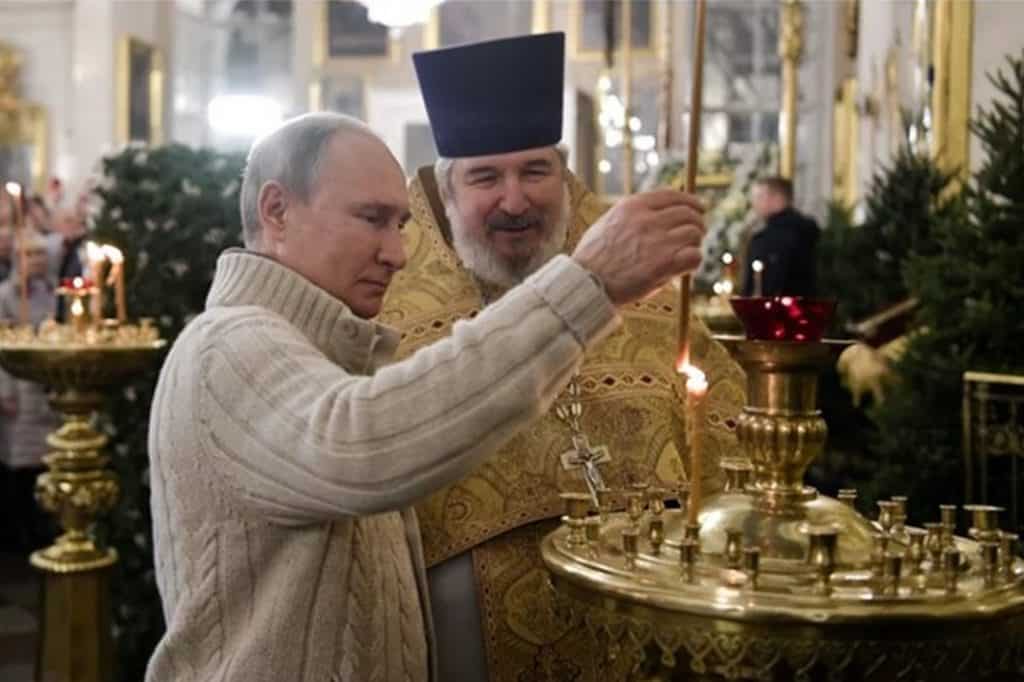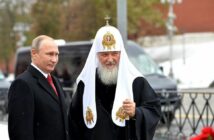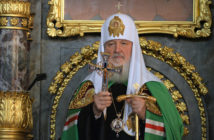Source: NPR
by Odette Yousef

Russian President Vladimir Putin attends a Christmas liturgy at the Transfiguration Cathedral in St. Petersburg early on Jan. 7, 2020. In the U.S., Orthodox Christianity is a relatively small faith tradition, but in recent years, it has expanded to new regions. Some new converts are using the religion to spread white nationalist views. Alexey Nikolsky/Sputnik/AFP via Getty Images
When Sarah Riccardi-Swartz moved from New York City to a small Appalachian town in West Virginia in the fall of 2017, she was searching for an answer to a puzzling question. Why had a group of conservative American Christians converted to Russian Orthodoxy?
“It’s typically an immigrant faith, so I was really interested in that experience and why it spoke to converts,” said Riccardi-Swartz, a postdoctoral fellow in the Recovering Truth project at Arizona State University.
Riccardi-Swartz’s study focused on a community of mostly former evangelical Christians and Catholics who had joined the Russian Orthodox Church Outside of Russia (ROCOR). The West Virginia location, in addition to having a church parish, was also home to the largest English-speaking Russian Orthodox monastery in the world.
Over a year of doing research, Riccardi-Swartz learned that many of these converts had grown disillusioned with social and demographic change in the United States. In ROCOR, they felt they had found a church that has remained the same, regardless of place, time and politics. But Riccardi-Swartz also found strong strains of nativism, white nationalism and pro-authoritarianism, evidenced by strong admiration for Russian President Vladimir Putin.
“For many of them, Putin becomes this sort of king-like figure in their narratives,” she said. “They see themselves as oppressed by democracy because democracy is really diversity. And they look to Putin because democracy isn’t really, as we see right now, an option [in Russia].”
She recently published a book based on her research that’s titled Between Heaven and Russia: Religious Conversion and Political Apostasy in Appalachia.
The case study that Riccardi-Swartz provides adds detail and color to a trend that a handful of historians and journalists have documented for nearly a decade. In publications mostly targeted toward an Orthodox Christian audience, they have raised the alarm about a growing nativist element within the church. Despite Orthodoxy’s relatively small imprint in the U.S., they warn that, unchecked, these adherents could fundamentally alter the faith tradition in the United States. They also warn that these individuals are evangelizing hate in the name of Orthodoxy in ways that could attract more who share those views.
“It’s an immigrant faith. It’s now being sort of colonized by these converts in many respects,” said Riccardi-Swartz. “They’re vocal in their parishes. They’re vocal online. They’re very digitally savvy and very connected to other far-right actors in the United States and across the globe. And that’s really changing the faith.”
Orthodoxy’s changing footprint in America
Despite centuries of presence in North America, starting in what we now know as Alaska, the Orthodox church in the U.S. is still relatively small. Alexei Krindatch, a sociologist of religion who focuses on Eastern Orthodox and Oriental Orthodox churches in the U.S., estimates that active adherents make up about 0.4% of the population. Within that, nearly two dozen branches are divided between what’s known as Eastern Orthodoxy and Oriental Orthodoxy. They include Greek, Coptic, Ethiopian, Armenian and more.
Eastern Orthodox churches, which include ROCOR, flourished in the U.S. starting at the turn of the 20th century, when migrants flocked to major industrial hubs like New York, Chicago, Detroit and Cleveland for jobs. Over time, these churches concentrated in the Northeast and West Coast. But more recently, the size and location of Eastern Orthodox churches in the U.S. has changed. According to Krindatch, who conducts censuses of Orthodoxy in the U.S., parishes declined in size between 2010 and 2020.
“This is in line with American mainline religion, [where]everyone is shrinking in size except nondenominational churches,” Krindatch said. But ROCOR, which Krindatch estimated in 2020 to have roughly 24,000 adherents, experienced a striking shift. While the number of ROCOR adherents declined by 14%, Krindatch found that the number of parishes grew by 15%.
“So what it means [is], we have more parishes, but which are smaller in size. And if you look at the geography, those parishes were planted not in traditional lands of Orthodoxy,” said Krindatch. The growth occurred in less populated areas of the Upper Midwest and Southern states, places with fewer direct links to Russia.
“So for me, those are a bunch of new ROCOR communities which are founded by convert clergy or by convert members,” Krindatch said.
Aram Sarkisian, a postdoctoral teaching fellow at Northwestern University’s Department of History, said this new growth from converts has helped some branches of Orthodoxy offset a decline in multigenerational families in the church. Sarkisian said these converts often find their way to Orthodoxy because they seek a haven for what they consider to be the most important cultural issues of the day.
“They’re drawn to what they believe to be conservative views on things like LGBTQ rights, gender equality. Abortion is a really big issue for these folks, the culture wars issues, really,” Sarkisian said. “And so they leave other faith traditions that they don’t believe to be as stringent about those issues anymore.”
Sarkisian said he began to see white nationalist and nativist views surface within Orthodox spaces online just around the time that these shifts began taking place.
“I first started noticing this around 2010, 2011 on Orthodox blogs, where I started to see language and rhetoric that was subtly racist and was subtly engaging in what we would now know as the alt-right,” Sarkisian said. “They bring it with them into the church because they see Orthodoxy as amenable to these goals, to these viewpoints.”
Orthodoxy and the Unite the Right rally
Perhaps the most well known among Orthodox converts who worked within alt-right circles was Matthew Heimbach. He had established the Traditionalist Worker Party, which helped organize a deadly gathering of neo-Nazis and white nationalists at the Unite the Right rally in Charlottesville, Va., in 2017. But years before that, Heimbach’s activities had already created waves within some Orthodox circles.
In 2014, he was excommunicated from the Antiochian Orthodox Christian Archdiocese of North America shortly after he had been accepted into it. During his brief time there, Heimbach’s activities with other Orthodox converts on a college campus in Indiana drew scrutiny. In explaining the decision to cut Heimbach off from the church, the priest who had brought him into the church explained, “I did not understand at that time that he held nationalistic, segregationist views.” Heimbach went on to join another branch of Orthodoxy.
“And then after that all happened, basically, the bishops said, ‘OK, it’s all done. There is nothing to talk about anymore and nothing here to see,’ ” said Inga Leonova, the founder and editor of The Wheel, a journal on Orthodoxy and culture.
Leonova, a member of the Orthodox Church in America, said she began following the trend of extremists joining Orthodoxy when she became aware of Heimbach’s campus activities. When she writes about the topic, she said she receives threats from within the Orthodox community. Still, she has felt that silence on the issue has caused greater harm. In the wake of the Unite the Right rally, she said that bishops across Orthodox jurisdictions ignored calls to condemn the event and the rise of extremist ideologies in the church.
“I think that there must be a presence of a certain amount of aloofness and the lack of desire to engage with these topics because there is an Orthodox story that Orthodoxy and politics don’t mix,” she said.
But Leonova said this is fiction. An Orthodox Church in America priest from Ohio was briefly suspended after he was seen in a video wearing his cassock on Capitol grounds on Jan. 6, 2021, after he attended the Stop the Steal rally in Washington, D.C. And Leonova said other clergy members, themselves American converts to the faith, have signaled their political viewpoints on their social media pages and personal blogs.
“There is a significant number of clergy whose social media profiles sport Confederate flags and support of the Southern cause,” she said.
ROCOR’s media-makers
Those who have followed the influx of extremists into American Orthodoxy agree that those individuals are fringe within the church and are mostly concentrated in newly founded ROCOR parishes. But they also warn that it would be foolish to ignore them. Of particular concern are the ways in which these individuals are networking with outside extremist groups and broadcasting their ideologies in the name of Orthodoxy.
“I do actually think it’s growing,” said George Demacopoulos, a professor and the director of the Orthodox Christian Studies Center at Fordham University. “I don’t think these people are necessarily changing the minds of people already in the church, but I do think they are bringing others culturally or politically like them into the church.”
In a viral social media clip pulled from a far-right internet talk show on the eve of Russia’s invasion of Ukraine, former Republican U.S. Senate candidate Lauren Witzke of Delaware praised Russia as a “Christian nationalist nation.” Witzke is studying to convert to ROCOR.
“I identify more with Russian — with Putin’s Christian values — than I do with Joe Biden,” Witzke said in the video. She declined to speak with NPR for this story.
Sarkisian said Witzke’s view typifies those of far-right converts to ROCOR, who have been receptive to Kremlin propaganda portraying Putin as a pious defender of Orthodoxy and traditional values. He said Putin also represents to them an appealing style of authoritarian leadership that challenges pluralism and liberal democracy in the United States.
“They are anti-democratic by nature,” Sarkisian said. “They are a part of these larger networks on the American far right, like Nicholas Fuentes and his America Firsters. They connect into these nodes that are challenging the very fabric of American democracy.”
Witzke, a MAGA supporter who ran on an anti-immigration platform in 2020, has appeared on Orthodox podcasts, where she has identified herself as aligned with the white nationalist America First movement. She also, at one time, seemed to support QAnon conspiracy theories but has since renounced QAnon. The media ecosystem she has participated in, a network of American converts to ROCOR who produce podcasts and live video chats online, presents a highly politicized interpretation of Orthodoxy to the world and one that many believe offers a distorted view of the church.
“This is how people are finding Orthodoxy now. They’re finding Orthodoxy through these YouTube shows. They’re finding it through these podcasts. They’re finding it through these blogs,” said Sarkisian. “They’re being radicalized by these folks on the internet, and that’s really dangerous.”
The channels revolve around themes of antisemitism, contempt for women’s and LGBTQ rights, xenophobia and support of white nationalists, including some who’ve been convicted of violent hate crimes. At times, clergy within ROCOR and other Orthodox branches have joined these online discussions, which may lend the appearance of sanctioning those views.
Some longtime ROCOR faithful have found these views bewildering, given the church’s history. Lena Zezulin, whose parents were among the founding members of a parish in Long Island, N.Y., said that the community was always inclusive of non-Christian Russian immigrants living among it and proud of its immigrant roots.
“We had Muslims in the community,” she recalled. “My summer camp had Buddhists in the community. So those people were kind of lovingly absorbed into the group because they all came over [to the U.S.]together.”
She said that the congregation and clergy also welcomed her African American husband when they married roughly 40 years ago. But over time, their children started to encounter racism in the church. Zezulin said it tracked with the church’s expansion to new regions of the U.S., where it was drawing new conservative converts. Zezulin said she believes tolerance for these views may explain why extremists with xenophobic and nativist views have been joining.
“It’s outrageous, given that we came here as refugees and were accepted,” she said. “I think it’s racism based.”

Lena Zezulin and her husband, Christopher Foreman, were married in a ROCOR parish in Roslindale, Mass., in 1980. Zezulin says that at the time, the church welcomed her husband.
Russia’s war in Ukraine
In general, those who have raised concern about racism and extremists’ participation within the church say the issue has largely been left to parish priests to address — or not to address. NPR reached out to Holy Trinity Orthodox Seminary near Jordanville, N.Y., ROCOR’s theological training institution, for comment on a number of questions, including how clergy are advised to handle the airing of antisemitic or nativist views by parishioners. Representatives declined to answer questions.
Most recently, Russia’s war in Ukraine has prompted painful reflection among some faithful. The head of the Russian Orthodox Church, Patriarch Kirill of Moscow, gave religious cover to the war. He claimed that the invasion of Ukraine is necessary to protect Orthodox Ukrainians from Western influence — namely, gay pride parades. Zezulin left her longtime ROCOR community and has started attending an Orthodox Church in America parish because her priest would not condemn the invasion.
“You know, somebody just said we should stand and pray for both sides. Well, were the Brits supposed to pray for Hitler and Churchill at the same time?” she said.
If anything, said Sarkisian, the war has exposed just how Putin has used the Russian Orthodox Church to further his country’s influence.
“It is definitely an arm of soft diplomacy, and ROCOR is a really important part of that,” Sarkisian said. “Putin is really interested in the church for its purposes for amplifying a particular aspect of Russian history politically, religiously, culturally.”



5 Comments
Democracy is diversity!? Lost me there, read some Plato, Mr. Greek!
USA is not a democracy but rather a constitutional republic.
The Moscow patriarchate recognized that its parishes in the US, originally planted by missionaries in Alaska, were mature enough to be granted autocephaly in 1970, as the OCA (Orthodox Church in America).
At that time ROCOR (the Russian Orthodox Church Outside of Russia) was not under the Moscow Patriarchate and it was considered “uncanonical”. Its parishes did not become part of the OCA. Why, after fifty years haven’t these ROCOR parishes joined the OCA? Why does the Moscow Patriarchate have any parishes in the territory of the US?
If the Assembly of Canonical Bishops of the US was doing it’s job, would ROCOR be included? How can the Assembly perform the charge given to it when it was created, “to bring the Church in the US into ‘canonical’ order” if Putin and Kirill can block any of its decisions?
The Bishops who understand their duties to the people in the US entrusted to them should move forward with their plan to unite and establish the American Orthodox Church without ROCOR or any other hold-outs. As long as the Assembly of Bishops proceeds with the understanding that it needs the permission of ROCOR or Putin/Kirill to bring the Orthodox Church in the US into canonical order, it is wasting its time.
It needs to reconvene as a Synod of the “willing”, elect its presiding bishop, declare itself an autocephalous local church.
A united, canonical American Orthodox Church can more effectively deal with problems and individuals that deviate from Orthodoxy than the current situation where someone who is excommunicated by one “jurisdiction” finds refuge in another, and teachings that are universally condemned, are welcomed in another.
It’s NPR. Anyone to the right of Stalin is “far right.” Oh, and Nazis aren’t “right wing,” nor is “racist” synonymous with “right wing.” Last time I checked, the only side that was digging in on biological essentialism (when it came to race, in any event) was the left.
Nonsense! NPR = US/globalist regime agitprop!